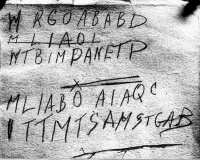Derek's wiki test space
Test space
| Heading 1 | Heading 2 |
|---|---|
| Data 1 | Data 2 |
Comment box
| Tip |
|---|
| Description to our knowledge, the provable security property is often taught as being self evident and is not questioned on any level (recent advances in quantum hacking may be an exception; however, such attacks are based on discrepancies between the model and real systems as opposed to the security of the model itself). The commonly cited reason for no-cloning or quantum entanglement is very far from sufficient. Even in the technical literature, a key is often regarded as perfect whenever it is used in an application. One main purpose of this paper is to correct such a misconception and to demonstrate how the imperfect generated key affects the security proofs themselves. |
Derek Abbott was born in South Kensington, London UK in 1960. In 1978, he began work at the GEC Hirst Research Centre, London, UK, and graduated from Loughborough University, UK, with a BSc (Hons) in Physics. At Hirst, he was a Research Engineer until 1986, working in CCD, SOS, CMOS, and vacuum microelectronic technologies. He also worked on solid-state image sensors in the optical and infrared regimes. He migrated to Australia in 1986, and worked at Austek Microsystems as an analog VLSI design engineer until 1987. In 1987-1990, he was a part-time Research Engineer at the University of Adelaide, and also consulted for a number of companies including Austek Microsystems and British Aerospace. In 1990, he took up a position as a Lecturer at the University of Adelaide, where he completed his PhD in Electrical & Electronic Engineering in 1995 and graduated in 1997. He was promoted to Professor in 2006. He is a Fellow of the Institute of Electrical & Electronic Engineers and also a Fellow of the Institute of Physics.
Symbol
__MATHJAX_NODOLLAR__ I owe you 20.
I owe you $20
I owe you $20
Infoboxtest
{{#ifeq:|yes||
{{#if:Infobox testing|}}{{#if:|{{#if:{{{above}}} ||{{#if:
|{{#if:
|
}}
}} }} }}{{#ifeq:|yes|{{#if:Infobox testing|Infobox testing}}}}{{#if:|{{#if:
||{{#if:
|{{#if:
|
}}
}} }}{{#if:|{{#if:
||{{#if:{{{subheader2}}}
|{{#if:
|
}}
}} }}{{#if: |{{#if:
|
|{{#if:
||{{#if: {{#if:|
{{#if:|
{{{caption1}}}}}
|{{#if:
|
}}
}} }}{{#if:|{{#if:
||{{#if:{{{image2}}}{{#if:|
{{{caption2}}}}}
|{{#if:
|
}}
}} }}{{#if:Main Heading
||{{#if:
|{{#if:
|
}}
}}{{#if:First set of data
||{{#if:Data
|{{#if:Label
|
}}
}}{{#if:Remove this line (optional)
||{{#if:More data
|{{#if:More Label
|
}}
}}{{#if:
||{{#if:
|{{#if:
|
}}
}}{{#if:
||{{#if:
|{{#if:
|
}}
}}{{#if:
||{{#if:
|{{#if:
|
}}
}}{{#if:
||{{#if:
|{{#if:
|
}}
}}{{#if:
||{{#if:
|{{#if:
|
}}
}}{{#if:
||{{#if:
|{{#if:
|
}}
}}{{#if:
||{{#if:
|{{#if:
|
}}
}}{{#if:
||{{#if:
|{{#if:
|
}}
}}{{#if:
||{{#if:
|{{#if:
|
}}
}}{{#if:
||{{#if:
|{{#if:
|
}}
}}{{#if:
||{{#if:
|{{#if:
|
}}
}}{{#if:
||{{#if:
|{{#if:
|
}}
}}{{#if:
||{{#if:
|{{#if:
|
}}
}}{{#if:
||{{#if:
|{{#if:
|
}}
}}{{#if:
||{{#if:
|{{#if:
|
}}
}}{{#if:
||{{#if:
|{{#if:
|
}}
}}{{#if:
||{{#if:
|{{#if:
|
}}
}}{{#if:
||{{#if:
|{{#if:
|
}}
}}{{#if:
||{{#if:
|{{#if:
|
}}
}}{{#if:
||{{#if:
|{{#if:
|
}}
}}{{#if:
||{{#if:
|{{#if:
|
}}
}}{{#if:
||{{#if:
|{{#if:
|
}}
}}{{#if:
||{{#if:
|{{#if:
|
}}
}}{{#if:
||{{#if:
|{{#if:
|
}}
}}{{#if:
||{{#if:
|{{#if:
|
}}
}}{{#if:
||{{#if:
|{{#if:
|
}}
}}{{#if:
||{{#if:
|{{#if:
|
}}
}}{{#if:
||{{#if:
|{{#if:
|
}}
}}{{#if:
||{{#if:
|{{#if:
|
}}
}}{{#if:
||{{#if:
|{{#if:
|
}}
}}{{#if:
||{{#if:
|{{#if:
|
}}
}}{{#if:
||{{#if:
|{{#if:
|
}}
}}{{#if:
||{{#if:
|{{#if:
|
}}
}}{{#if:
||{{#if:
|{{#if:
|
}}
}}{{#if:
||{{#if:
|{{#if:
|
}}
}}{{#if:
||{{#if:
|{{#if:
|
}}
}}{{#if:
||{{#if:
|{{#if:
|
}}
}}{{#if:
||{{#if:
|{{#if:
|
}}
}}{{#if:
||{{#if:
|{{#if:
|
}}
}}{{#if:
||{{#if:
|{{#if:
|
}}
}}{{#if:
||{{#if:
|{{#if:
|
}}
}}{{#if:
||{{#if:
|{{#if:
|
}}
}}{{#if:
||{{#if:
|{{#if:
|
}}
}}{{#if:
||{{#if:
|{{#if:
|
}}
}}{{#if:
||{{#if:
|{{#if:
|
}}
}}{{#if:
||{{#if:
|{{#if:
|
}}
}}{{#if:
||{{#if:
|{{#if:
|
}}
}}{{#if:
||{{#if:
|{{#if:
|
}}
}}{{#if:
||{{#if:
|{{#if:
|
}}
}}{{#if:
||{{#if:
|{{#if:
|
}}
}}{{#if:
||{{#if:
|{{#if:
|
}}
}}{{#if:
||{{#if:
|{{#if:
|
}}
}}{{#if:
||{{#if:
|{{#if:
|
}}
}}{{#if:
||{{#if:
|{{#if:
|
}}
}}{{#if:
||{{#if:
|{{#if:
|
}}
}}{{#if:
||{{#if:
|{{#if:
|
}}
}}{{#if:
||{{#if:
|{{#if:
|
}}
}}{{#if:
||{{#if:
|{{#if:
|
}}
}}{{#if:
||{{#if:
|{{#if:
|
}}
}}{{#if:
||{{#if:
|{{#if:
|
}}
}}{{#if:
||{{#if:
|{{#if:
|
}}
}}{{#if:
||{{#if:
|{{#if:
|
}}
}}{{#if:
||{{#if:
|{{#if:
|
}}
}}{{#if:
||{{#if:
|{{#if:
|
}}
}}{{#if:
||{{#if:
|{{#if:
|
}}
}}{{#if:
||{{#if:
|{{#if:
|
}}
}}{{#if:
||{{#if:
|{{#if:
|
}}
}}{{#if:
||{{#if:
|{{#if:
|
}}
}}{{#if:
||{{#if:
|{{#if:
|
}}
}}{{#if:
||{{#if:
|{{#if:
|
}}
}}{{#if:
||{{#if:
|{{#if:
|
}}
}}{{#if:
||{{#if:
|{{#if:
|
}}
}}{{#if:
||{{#if:
|{{#if:
|
}}
}}{{#if:
||{{#if:
|{{#if:
|
}}
}}{{#if:
||{{#if:
|{{#if:
|
}}
}}{{#if:
||{{#if:
|{{#if:
|
}}
}}{{#if:
||{{#if:
|{{#if:
|
}}
}}{{#if:|}}{{#if:|}}
{{#ifeq:|yes||}}
OK this is the test bed for the u-beaut infobox. What a pain to install. For the record, I followed the info at this link: http://www.etcwiki.org/wiki/Mediawiki_template_guide
Why the heck why isn't this a file you can just unpackage into a directory rather than having to manually create 20 files, I don't know.
I owe you $20
More Testing
According to scientists, the Sun is pretty big.[1]
The Moon, however, is not so big.[2]
MathJax Test
Here is an inline equation: \( x^2 \)
Here is a display equation: \begin{align} \int 2x \; dx &= x^2 + C \tag{1}\label{eqn:integral} \end{align}
That last equation was Eqn. \ref{eqn:integral}.
\( \int_a^y f(\alpha\,)\,dy , \)
and in display form
\[ \int_a^y f(\alpha\,)\,dy . \]
Scratch
Therefore, the minimal cost = $50 million 360 = $18,000 million = $18 billion. The maximal cost is = $50 million 20,300 = $1,016,500 million = $1 trillion (approx).
Scratch pad downloads
Presentations
- https://www.youtube.com/watch?v=4P61D6JbgHE
- Proposal seminar slides
- Proposal seminar slides
- Final seminar slides
- Final seminar video
